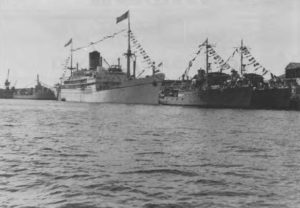- Author
- Hall, Roy
- Subjects
- History - post WWII
- Tags
-
- RAN Ships
- HMAS Stirling (Shore establishment), HMAS Fremantle I, HMAS Junee, HMAS Mildura
- Publication
- September 1990 edition of the Naval Historical Review (all rights reserved)
Then followed a brief call at Onslow where we berthed at the end of a mile long jetty to discharge some stores shipped from Fremantle. Here the gangway ranged from horizontal to near vertical in a very short time and the surging tides played havoc with fenders and wires to such an extent that it was wise to anchor off during the height of the ebb and flow of the tide.
To the North off the coast lay the Monte Bellos. We passed Barrow Island on the way, no oil had been discovered there in those times. Evening twilight and dawn sights were the order of the day. No satellite navigation then either. There was much poring over the navigation tables for those of us who were formula navigators using the Marc St. Hillaire method, and was the intercept towards or away?
The islands were where we expected them to be, Trimouville, Hermit, Northwest and many more. From seawards the islands appeared as barren profiles and most uninviting. We did not land but we sounded our way cautiously into various bays and anchorages, with a constant lookout for coral outcrops in the lagoons. One corvette had previously damaged her Asdic dome. During this time we took lots of compass bearings and horizontal sextant angles, accurate in poorly charted waters, and was great value for money, for all concerned.
Before departure from the Monte Bellos, a suitable rocky islet was chosen for some gunnery practice. Bombardment commenced with the forecastle four inch (with shot carefully doled out to conform with the Reserve allocation), controlled hopefully from the bridge. In my case it was ruined by a bout of laryngitis. The local bird population was in no danger.
The next day we made a predawn approach towards Cape Preston and the Fortesque River estuary. It is difficult to see land once the sun is up and full in your eyes. The tide raced across the seascape and course corrections of up to 40 degrees were necessary to maintain our heading at moderate speeds.

Once anchored the motor boat was away and for the ensuing days we were busy laying a series of 44 gallon drums to mark the channel into and up the river. It was planned to install a standpipe on a lagoon of freshwater near an old wool loading jetty. This was to enable a small tanker to load water for transit to the Monte Bellos. In the event the RN Taskforce brought its own LST fully equipped to distill the Fleet’s requirements of fresh water.
On one occasion we were trailed by a dark shadow almost as long as the motor boat. A shark, or was it a crocodile? No one wanted to go swimming after that.
Towards the end of our training period we returned to Onslow to exchange with another draft of Reservists newly arrived from Perth. Our 13 days were just about over, after a hot dusty ride out to the local airstrip and a ride southwards in a bumbling DC3 on the milk run.
Back in Perth and with our training adventures behind us it was back to work on Monday and looking forward to next year’s ACT.




